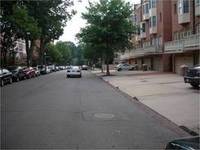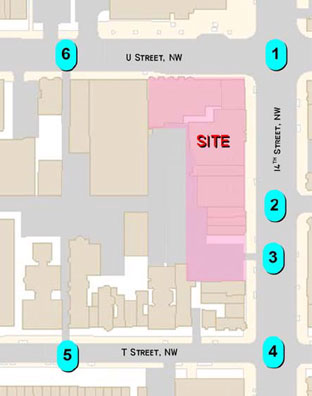DDOT anti-curb cut regulation important but needs flexibility

2100 block of O St, NW. From CSG.
DDOT has proposed new regulations to limit curb cuts. As we’ve discussed before, garage entrances that face the street and cut across sidewalks have a profoundly damaging effect on walkable urbanism. They make the street feel much more vehicle-centric, the cars crossing the sidewalk add opportunities for crashes, and by taking away on-street parking, they widen the street, leading cars to drive faster.
According to DDOT’s proposed regulation, they will not approve any new curb cuts, or allow existing ones to remain if a building is renovated, if the parking could be accessed from an alley instead of from the street. (There’s a typo in the draft which makes it sound like the opposite, but that’s what they mean). Under this policy, buildings without alleys could still end up with front entrances, like this; however, under the proposed off-street parking zoning rules, buildings without alleys wouldn’t have any requirement to build parking. They still might, and could get a curb cut, but the policy is a big improvement over the current situation.
It’s very important to have a regulation like this. Right now, DDOT often opposes curb cuts, as with the drive-thru Walgreens, but that’s dependent on having a good ward planner with the time and awareness to get involved. This policy would standardize curb cut criteria.
Under this policy, there are only two exceptions: first, if “there is no alternative way to access on-site parking or a loading dock” via the alley, and second, in the event of special needs due to a disability. You might be surprised, but I actually think DDOT ought to have a little bit more flexibility.
Some blocks do have alleys, but alleys unsuited to heavy traffic volume. In some downtown blocks, the garages see a lot of car traffic in and out, while the alleys are narrow and provide insufficient room for cars and trucks to maneuver. Plus, any traffic in and out of an alley crosses the curb, just as it does on a curb cut. The only advantage of the alley is that we consolidate the pedestrian conflicts into a single area.
If we’re building new blocks, then all parking absolutely should go through the alley. If we’re substantially renovating most of a block and changing alleys around, as big downtown development projects often do, they they should leave enough space behind the buildings to handle the parking traffic. And for a small residential building with low traffic volume, we should absolutely use the alleys.
But there may be some situations where an alley exists and using it is possible, but undesirable. DDOT needs the flexibility to grant an exeption in these rare cases. One example is the 14th and U project, which backs onto the Treto Way alley between T and U just west of 14th Street.
This alley is unusual: instead of running linearly through a block or making an L shape, as most alleys do, this one looks like a capital H with a capital I on top of it. To get to the proposed parking entrance, all cars will have to make a 90-degree turn, and traverse a relatively narrow space in two-way traffic. Further, this alley already has a substantial amount of truck traffic. A few residents live off the alley, and there are also some businesses with their entrances facing the alley. I bicycled over there recently, and had to dismount to carefully walk around a truck not once but twice.
Neighbors are pushing for the building’s garage to face 14th (location #3 in the image above) instead of the alley. DDOT and HPRB both opposed the idea. Responding to neighborhood pressure, DDOT commissioned a traffic study of the alley system, which recommends locating the garage on 14th as neighbors are suggesting.
The study seems to focus primarily on vehicle Level of Service with very little analysis of pedestrian safety. However, it does point out that the sidewalk on U Street between 14th and 15th is very narrow, and vehicles entering or exiting there (location #6 above) may pose more danger to pedestrians than on wider 14th, especially if the cars exit onto U. With all the trucks backing up and maneuvering in that area, traffic may also back up out of the alleys onto the surrounding streets and block sidewalks.
After investigating the area and talking to nearby businesses and residents, I’ve actually become convinced that a parking entrance would cause problems and may even worsen pedestrian safety (though I wish Gorove/Slade had done a more thorough analysis of that). The best solution would be less parking, but that’s not what the developer wants and zoning still won’t allow it. Therefore, I support the developer’s request to DDOT, BZA, and HPRB to allow this garage entrance and curb cut.
Perhaps the regulations as written provide a process for getting an exception that’s not spelled out here. If so, great. If not, we should have one. It shouldn’t be easy for a developer to get a curb cut if there’s an alley, and a bad DDOT planner shouldn’t be able to grant one lightly. But if a garage is going to draw substantial traffic into an alley system that’s not able to handle it, then an occasional exception is simply common sense.

